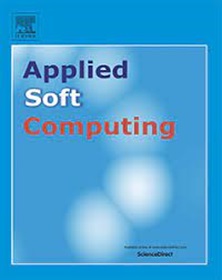A sparse diverse-branch large kernel convolutional neural network for human activity recognition using wearables
IF 7.2
1区 计算机科学
Q1 COMPUTER SCIENCE, ARTIFICIAL INTELLIGENCE
引用次数: 0
Abstract
During the past decade, large convolutional kernels have long been under the shadow of small convolutional kernels since the introduction of VGG backbone network. It always remains mysterious whether one can design pure convolutional neural network (CNN) while plugging larger kernels to model long-range dependency for human activity recognition (HAR), which has been rarely explored in previous literatures. In this paper, we revive the usage of larger kernels in the context of HAR and attempt to eliminate the performance gap between large kernels and small kernels by strategically applying a large receptive field, without incurring high memory and computational footprints. Built on two recipes, i.e., Diverse-Branch and Dynamic Sparsity, we design a pure CNN architecture named SLK-Net for activity recognition, which is equipped with sparse diverse-branch larger kernels. To validate the effectiveness of our approach, we perform a series of extensive experiments on four public benchmarks including UCI-HAR, WISDM, UniMiB-SHAR and USC-HAD, which show that large kernels can benefit its ability to capture long-range dependency and consistently beat state-of-the-art small-kernel counterparts across a wide range of activity classification tasks. Real activity inference latency is measured on a mobile device, which reveals that such sparse diverse-branch kernels can lead to inference speedup than vanilla large kernels. We hope this work may further inspire relevant CNN-based studies in the HAR community.
利用可穿戴设备识别人类活动的稀疏多样分支大核卷积神经网络
在过去十年中,自 VGG 骨干网络问世以来,大卷积核一直处于小卷积核的阴影之下。在设计纯卷积神经网络(CNN)的同时,是否可以插入更大的内核来为人类活动识别(HAR)建立长距离依赖关系模型,这在以往的文献中鲜有探讨,一直是个谜。在本文中,我们将在 HAR 的背景下重新使用大内核,并尝试通过战略性地应用大感受野来消除大内核与小内核之间的性能差距,同时不会产生高内存和计算足迹。我们基于 "多样化分支 "和 "动态稀疏性 "这两种方法,设计了一种名为 "SLK-Net "的纯 CNN 架构,用于活动识别,该架构配备了稀疏的多样化分支大内核。为了验证我们的方法是否有效,我们在 UCI-HAR、WISDM、UniMiB-SHAR 和 USC-HAD 等四个公开基准上进行了一系列广泛的实验,结果表明大内核可以提高捕捉长距离依赖性的能力,并在广泛的活动分类任务中持续击败最先进的小内核同行。我们在移动设备上测量了实际活动推理延迟,结果表明这种稀疏多样分支内核比香草大内核的推理速度更快。我们希望这项工作能进一步激发 HAR 界基于 CNN 的相关研究。
本文章由计算机程序翻译,如有差异,请以英文原文为准。
求助全文
约1分钟内获得全文
求助全文
来源期刊

Applied Soft Computing
工程技术-计算机:跨学科应用
CiteScore
15.80
自引率
6.90%
发文量
874
审稿时长
10.9 months
期刊介绍:
Applied Soft Computing is an international journal promoting an integrated view of soft computing to solve real life problems.The focus is to publish the highest quality research in application and convergence of the areas of Fuzzy Logic, Neural Networks, Evolutionary Computing, Rough Sets and other similar techniques to address real world complexities.
Applied Soft Computing is a rolling publication: articles are published as soon as the editor-in-chief has accepted them. Therefore, the web site will continuously be updated with new articles and the publication time will be short.
 求助内容:
求助内容: 应助结果提醒方式:
应助结果提醒方式:


